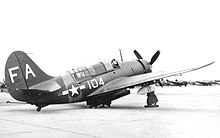Lotniskowce typu Saipan
| ||
 | ||
| Kraj budowy | ||
| Użytkownicy | US Navy | |
| Stocznia | New York Shipbuilding Corporation | |
| Wejście do służby | 1944 | |
| Zbudowane okręty | 2 | |
| Dane taktyczno-techniczne | ||
| Wyporność | standardowa: 14 500 długich ton (ts) całkowita: 19 000 ts | |
| Długość | 208,7 m | |
| Szerokość | na linii wodnej: 23,4 m całkowita: 35 m | |
| Zanurzenie | 8,5 m | |
| Napęd | Turbiny parowe o mocy 120 000 shp połączone z 4 wałami | |
| Prędkość | 33 węzły | |
| Załoga | 1 700 | |
| Uzbrojenie | 42 × Bofors 40 mm 16 × Oerlikon 20 mm | |
| Wyposażenie lotnicze | 18 × Grumman F6F Hellcat 12 × Curtiss SB2C Helldiver 12 × Grumman TBF Avenger | |
Lotniskowce typu Saipan – lotniskowce lekkie floty amerykańskiej podczas II wojny światowej. Ogółem wprowadzono do służby tylko 2 jednostki tego typu. Bazowały na kadłubach ciężkich krążowników typu Baltimore[1]. Po wojnie zostały zmodernizowane. USS „Saipan” został przemianowany na okręt komunikacji radiowej Arlington (AGMR-2), natomiast USS „Wright” – na okręt dowodzenia Wright (CC-2)[1]. W tych rolach okręty służyły do 1970 roku, a następnie zostały wycofane z eksploatacji i oddane na złom w 1980 roku.
Ukończone okręty typu Saipan
| Oznaczenie | Nazwa | Zdjęcie | Wejście do służby | Wycofanie ze służby |
|---|---|---|---|---|
| CVL-48 | „Saipan” |  | 14 lipca 1946 | 14 stycznia 1970 |
| CVL-49 | „Wright” |  | 9 lutego 1947 | 27 maja 1970 |
Wyposażenie lotnicze
Na wyposażeniu okrętów docelowo miały być 42 samoloty o 3 rodzajach: myśliwskie, bombowce nurkujące oraz torpedowe.
| Nazwa | Typ | Zdjęcie | Ilość |
|---|---|---|---|
| Grumman F6F Hellcat | Samolot myśliwski |  | 18 |
| Curtiss SB2C Helldiver | Bombowiec nurkujący |  | 12 |
| Grumman TBF Avenger | Samolot torpedowy |  | 12 |
Przypisy
- ↑ a b The Saipan class (ang.). globalsecurity.org. [dostęp 2016-06-06].
Bibliografia
- Norman Friedman: U.S. Aircraft Carriers: An Illustrated Design History. Annapolis: Naval Institute, 1983. ISBN 0-87021-739-9.
Linki zewnętrzne
- Lekkie lotniskowce typu Saipan (ang.). [dostęp 2016-06-06].
- Lotniskowce typu Saipan (fr.). [dostęp 2016-06-06].
Media użyte na tej stronie
The flag of Navassa Island is simply the United States flag. It does not have a "local" flag or "unofficial" flag; it is an uninhabited island. The version with a profile view was based on Flags of the World and as a fictional design has no status warranting a place on any Wiki. It was made up by a random person with no connection to the island, it has never flown on the island, and it has never received any sort of recognition or validation by any authority. The person quoted on that page has no authority to bestow a flag, "unofficial" or otherwise, on the island.
Autor: Bill Larkins, Licencja: CC BY-SA 2.0
General Motors TBM-3E at NAS Alameda in March 1946
The U.S. Navy light aircraft carrier USS Saipan (CVL-48) with Sikorsky HRS and Piasecki HUP helicopters on her flight deck, circa the mid-1950s.
Autor: Bill Larkins, Licencja: CC BY-SA 2.0
At Oakland on June 10, 1948.
The U.S. Navy light aircraft carrier USS Saipan (CVL-48) underway circa the mid-1950s, with eleven Douglas AD Skyraider of Marine Attack Squadron 324 (VMA-324) "Vagabonds" planes parked on her flight deck, aft. Note the submarine approaching, in the right distance.
The U.S. Navy light aircraft carrier USS Wright (CVL-49) operating on training duty, with six North American SNJ Texan aircraft on deck lined up for takeoff, circa the later 1940s or early 1950s.
The photo's original caption reads "The stage is set for the final scene of Basic Training: the flight students will qualify six carrier landings in SNJ 'Texans' and the curtain will descend on the graduation finale."






